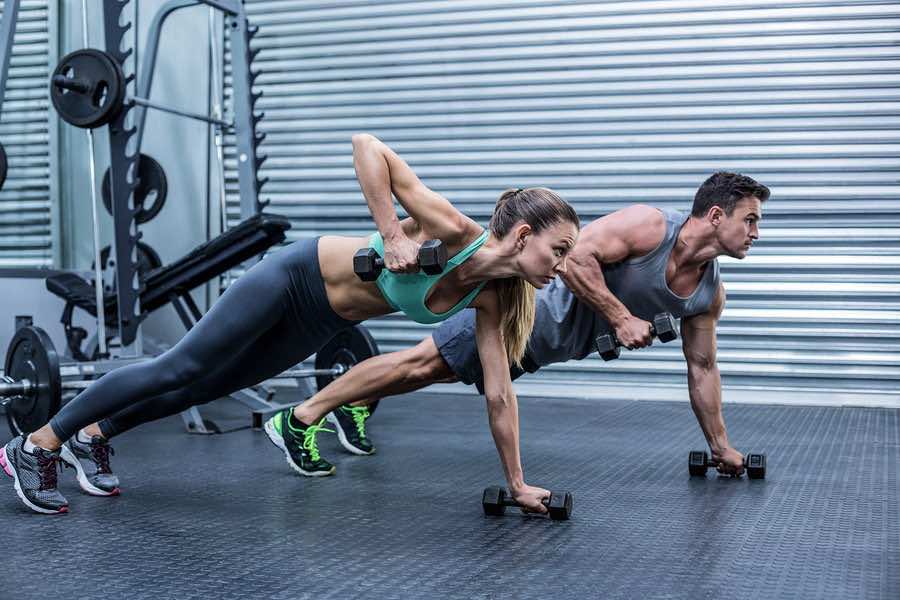
What Is Functional Training? – An Introduction To The Benefits Of Functional Exercise


What Is Functional Training? – An Introduction To The Benefits Of Functional Exercise
When some people walk into the gym, the number one thing they want to accomplish is a better looking body.
They are training for aesthetic purposes only. They want to grow bigger arms, slim their waist, or round out their backside.
Others however, don’t especially care so much about the looks department. Sure, they want to look good (who doesn’t?!), but it isn’t their top priority when it comes to their training routine.
For these people, exercise is more about improving performance. Perhaps they are looking to do some sport specific training to excel at their sport, or they may simply want to become more functional in everyday life, feeling like an athlete, even though they may not be actively engaging in sports.
For these people, it’s more about what the exercises will do for their body rather than how it will make them look.
These are the people who will benefit from functional training exercises.
If you’ve ever wondered just what is functional training, the following is going to guide you through this form of exercise and give you the answers you need to know.
Before we get started, check out this video where I illustrate what functional training can do for you.
Functional Training 101
So what exactly is functional training? And, how can you benefit?
Functional strength training, as the name suggests, is physical training that helps you become more functional.
Stop for a moment and think about everything that you are doing on a day to day basis.
You’re walking from your bedroom to your kitchen. You’re lifting a heavy object to a shelf above your head. You’re carrying in groceries from the car. You’re walking up a flight of stairs.

These are just a few of the main things that you will be doing throughout your day.
Now, what if all of those tasks could become easier?
With functional training exercises, they can.
When you are utilizing a functional strength training program, every single exercise you do will have a purpose. It will have transfer over benefits to your everyday life.
For instance, performing a leg extension would likely not be a part of a functional training workout routine.
Why?
How often are you performing that same movement pattern in everyday life? Hardly ever (or never!).
Squats on the other hand – chances are you are squatting at least 10-15 times per day. You squat every time you sit down to eat a meal or go to work at your desk.
This is a highly functional exercise and one that would be included over and over again in your training program.
Functional training is all about strengthening whole body movement patterns. It’s less about picking one specific muscle group and making it grow. This is more what bodybuilding training is all about.
With bodybuilding, you are trying to shape the perfect physique. You are looking at your body symmetry, how developed certain muscles are compared to other muscles. You are basically turning your body into a piece of art.
[sc name=”start-alert” ]Free Bonus: Download the 12 Week To Doubling Your Energy course for FREE right now and learn the art of snacking properly to encourage a leaner body composition.[sc name=”end-alert” ]
With functional training, it’s quite the opposite. You’re hardly ever looking at just a single muscle because rather, you are focusing on movement patterns.
And more often than not, movement patterns require that multiple muscle groups to exercise whatever movement it is that you are trying to create.
Functional training is also highly applicable to sports training. In fact, sport specific training and functional training can pretty much be utilized interchangeably.
When you are participating in high level sports, your primary goal of ay off-court/ice/field conditioning is to improve your ability to perform the sport of choice.
For instance, a football player is not going to be interested in how big his biceps are. Instead, he’s going to be interested in how strong his chest, back, and shoulders are, which will enable him to toss the ball across the field.
Likewise, a marathon runner is not going to be interested in whether his quads have grown an inch. For him, the primary goal of his training is to delay the onset of muscular fatigue so that he can constantly travel the long distances required by his sport.
These individuals will want to be performing sports specific training, which utilizes functional training exercises that mimic the movement patterns they use during their sport of choice.
By doing so, they can become stronger in those movement patterns so that next time they are out playing, they put forth a superior athletic performance.
Functional training, when done properly, is also a great way to reduce sports injuries.
For instance, as a football player, being tackled is all part of the game. The stronger your core support is however, the harder you’ll be able to tackle down to the ground because you’ll simply be more stabilized on your feet.

Functional training with lots of core work can help you achieve this. This in turn could result in you being moved in an undesirable manner, which would then lead to a serious potential injury as you are tackled to the ground.
With functional training, there is great variety in the end goal. While with classic bodybuilder training, the end goal is usually always about the same – look better aesthetically, with functional training, what one person has as a goal may be completely different from that of another.
Since it’s all about improving function and each persona’s functions will be different depending on what they are doing in their life, their program needs to be customized to meet their needs.
Who Needs Functional Training?
So this brings us to the next point to discuss – who needs functional training?
Who can benefit?
In a word, just about everyone.
Even those who are focusing on improving their aesthetic appearance should still be doing some degree of functional training as part of their program.
If you aren’t training functionally, you really aren’t seeing much benefit outside of the gym. Even those who want to walk on stage at a fitness event still need to be able to carry in groceries out of the car, walk up a few flights of stairs without being winded, as well as prevent lower back pain that could plague them for the coming years of their life.
Everyone can see transfer over benefits from the right functional strength training program into their day to day life.
Some of the individuals who will see excellent benefits from including functional training in their workout routine include:
- Athletes who are training hard to excel at their sports
- Athletes who are currently injured and are looking to re-habilitate themselves so they can begin training
again - Individuals who are looking to improve their energy level on a day to day basis
- Older adults who feel themselves growing weaker with age and want to regain former lost strength
- Individuals who simply want to feel more athletic in their daily activities
Just about everyone will benefit from adding functional training to their workout routine. And what’s more is that due to the nature in which functional training is set-up, it will also be excellent for providing fat burning and muscle building benefits.
Therefore, those who are looking for weight control can also benefit from including functional training exercises in their workout routine. This said, they may not get the aesthetic benefits that they would if they were performing conventional bodybuilding training, but there’s no question that someone will look better upon including functional training in their workout routine.
Let’s outline the main benefits functional training has to offer.
Benefits Of A Good Functional Training Workout Routine
The benefits of functional training cannot be stated enough. When many people hear the term ‘functional training’, they tend to immediately think athlete or older adult who needs help maintaining their daily functioning capacities.
And while, as illustrated above, both of these groups of people can highly benefit, they are not the only ones. With so many great benefits to be had from functional training, it’s clear that it should be a part of all workout programming.
Here’s what you stand to gain:
ü Time efficient workout – most functional training workout routines can be performed in as little as 20-30 minutes, 3 times per week
ü Improved rates of fat burning due to the compound nature of the lifts being utilized
ü Increased cardiovascular benefits thanks to the structure of the workout program
ü Improved muscular strength, leading to improved power output
ü Increased lean muscle mass development, resulting in a higher resting metabolic rate
ü Reduced risk of injuries, both sports/exercise related as well as those related to daily activities
ü Improved heart health (lower blood pressure, reduced cholesterol)
ü Decreased stress levels
ü Fun workouts that are constantly changing
ü Stronger bones and a lower risk of suffering from osteoporosis
Essentially any benefit you can get from a strength training workout program, you can also get from functional training as well.
[sc name=”start-alert” ]Also for you: Download the 12 Week To Doubling Your Energy course for FREE right now and learn the top strategies for lowering your stress level and improve your focus and concentration.[sc name=”end-alert” ]
Now let’s move forward and talk about the best exercises to be including in your functional training program.
The Best Functional Training Exercises
Exercise selection with functional training is all about analyzing movement patterns, as noted above.
Rarely are you going to be performing isolation moves as they just don’t mimic those activities done in daily activities.
Instead, functional training strength training programs will revolve around compound lifts that utilize a number of muscle groups at once.
You’ll perform exercises such as:
- Squats
- Deadlifts
- Push-ups
- Pull-ups
- Barbell shoulder presses
- Bent over barbell rows
- Step-ups
- Walking lunges
- Stair climbing
- Uphill walking/sprinting
- Plank holds (for functional core strength)
- Wood choppers
While this isn’t to say that you cannot include any isolation exercises in a functional training program, they simply should not be the focus.
At times, if one particular smaller muscle group is resulting in a lower performance on your functional based exercises, then adding the isolation exercise to this can help you later on improving your performance on that target functional exercise.
Each isolation, less functional exercise you add should have a purpose in terms of improving functional purpose, even if it doesn’t directly do so.
When it comes to sports specific training, often coaches who are highly trained and educated in the sport at hand will be your best advisors on what types of functional training you should be doing. If they have a background in both the sport as well as in personal training, they can guide you on the best exercises to do in the weight room to best complement the sport that you are trying to perform.
For instance, a hockey player will want to work hard on improving his slap shot, which means having a very strong back and core. This will help him generate a high degree of force as he twists his back and brings the stick behind him before taking the slap shot.
On the other hand, a basketball player will want to develop his vertical jumping skills, so for him, exercises such as box squats may be the better functional training exercise.
He may also perform pause squats using moderately heavy weight and a fast tempo to rise upward, which will help strengthen his quads and improve his rebounding ability.
(image of basketball player doing a jump shot)
As you can see, without fully understanding the sport in question, it can be hard to develop a functional training program to match. Each movement pattern in the sport needs to be analyzed and then you need to think about which exercises will most work with those movement patterns.
The basics – squats, push-ups, and deadlifts, will help just about any athlete as they are developing full body strength and power, however when you start getting a bit more intricate, that’s where complete customization is key.
Structuring Your Functional Strength Training Routine
So all of this said, how do you go about structuring your strength training routine?
There are a few questions that you need to look at as you develop the workout protocol.
What Energy Systems Are Being Utilized?
The first thing to look at is what energy systems are being utilized. A tennis player for instance, who performs a number of very short rounds in the sport would need to train differently than say a soccer player, who is constantly running throughout their session on the field.
For the soccer player, the workout protocol developed would want to include higher rep, longer duration sets, while the tennis player may focus on maximum power, shorter duration sets.
If the sport was more of an aerobic focused activity, the athlete would also likely want to be doing cardio training that mimicked that activity of choice.
A soccer player could perform longer duration running for instance while a football player may get more involved in sprint training.
[sc name=”start-alert” ]Check It Out:Download the 12 Week To Doubling Your Energy course for FREE right now and learn the number one exercise for boosting heart health and burning fat at top speed.[sc name=”end-alert” ]
Is The Activity Repetitive?
The next question to look at is whether the activity in question is repetitive. Are you looking to just develop strength to do something once or do you need strength to do it multiple times over?
For most ‘lifestyle’ functional training activities, it’s just one rep that needs to be completed. You need to lift the box overhead just once or carry the groceries in from the car once per day (although there may be a couple of trips involved).
In many sports training programs however, the activity is much more repetitive. A tennis player for instance is going to strike the ball multiple times before rest is given as they rally the ball back and forth.
The more repetitive in nature the activity is, the higher the reps per set you should perform.
Is Sheer Strength Or Quickness Required?
Finally, the last thing to consider is whether you need sheer strength or quickness for your activity of choice.
Some athletes for instance need to not just be strong, but be quick as well. It does a tennis player no good to be incredibly strong if they are slow to move and always miss the ball.
When quickness is required, the tempo should be adjusted when going about the workout routine. Rather than saying lifting with a standard tempo of 3 seconds to lift the weight, a one to two second pause at the top, and then another three seconds to lower the weight, the tempo might be one second to lift the weight, a one second pause, and then three seconds to lower the weight.’
This will help the athlete develop that quick muscular contraction ability that will really enhance their performance.
If, on the other hand, sheer strength is required, tempo likely won’t be of concern. In that case, slowly lifting the weight up may be the best option as this will ensure maximum muscle fiber recruitment and prevent any momentum from being called into play.
If you are looking to use functional training to improve your overall day to day capabilities, then chances are this is more along the lines of how you will be training.
As you can hopefully see, there is no one-size-fits-all functional strength training workout routine. Instead, you need to take into account your specific needs, preferences, and what you are trying to accomplish.
Then from there, you can put together a plan that will help you achieve the results that you are looking for.
Your functional fitness training program will also likely change as you go through time. At some points you may be focusing on sport specific activities for instance and then a little while later, you may be more focused on doing what you can to sustain everyday functioning in real-life situations.
As you age, functional training becomes increasingly important, but will take on a new light once again.
So there you have the facts on functional training. It really is a smart way to train because it ensures that all the time you spend in your training routine is time well spent and is going to pay off over the long-haul.
The last thing most people want is to be putting in hours in the gym each week without seeing any direct benefits other than how they look.
Functional training ensures that the hard work is noticed and you not only look better every day, but feel better as well.
What has been your experience with functional training? Comment and leave your thoughts about this style of training below.
Want to learn more about how you can train your body properly and enhance your health? If so, you’ll want to check out my complete course where I go over everything – fitness training, nutrition, and what you can do to keep your mind in top shape as well.
Frequently Asked Questions
6 Comments
Leave a Comment
You must be logged in to post a comment.






Thanks for helping me understand more about functional training. I hadn’t heard of it before, but it’s good to know that it can reduce sports injuries if it’s done properly. I can imagine how important this is, especially if you participate in a physical sport, like football as you mentioned. Seems like it could be a good trick to try and keep any injuries you may receive to a minimum. Better to prepare for it in advance than regret it later.
Hello,
Thank you for contacting BiOptimizers! We do apologize for just responding to you. Reason being, we had issues with our system, and we were unable to see these comments left by our customers. I am happy that this article was helpful to you. If you currently, have any questions, please contact us via email at [email protected]. Or call us at 1-800-719-2467 and one of our agents would be more than happy to assist you. Take care and have a great day!
My very best regards,
Njideka
Happy Health Concierge
BiOptimizers
Thank you for helping out, great information.
Hello ,
My name is Camille, and I am your Happy Health Concierge here at BiOptimizers. Thank you for contacting BiOptimizers! We do apologize for just responding to you. Reason being, we had issues with our system, and we were unable to see these comments left by our customers. However, we do appreciate your feedback. If you currently, have any questions, please contact us via email at [email protected]. Or call us at 1-800-719-2467 and one of our agents would be more than happy to assist you. Take care and have a great day!
My very best regards,
Camille
Happy Health Concierge
BiOptimizers
Good post. I certainly appreciate this website. Keep writing!
Thank you for contacting BiOptimizers! We do apologize for just responding to you. Reason being, we had issues with our system, and we were unable to see these comments left by our customers. If you currently, have any questions, please contact us via email at [email protected]. Or call us at 1-800-719-2467 and one of our agents would be more than happy to assist you. Take care and have a great day!